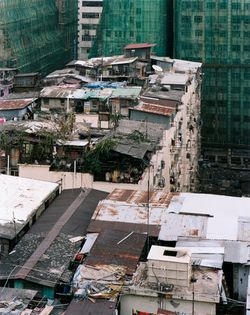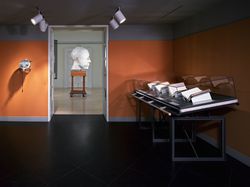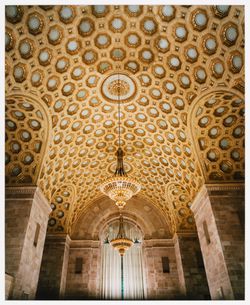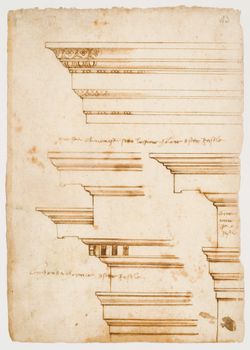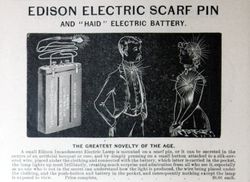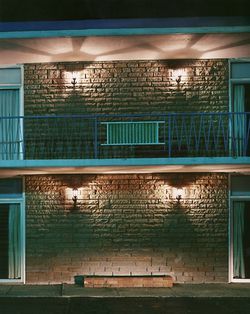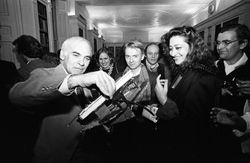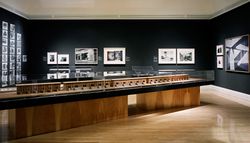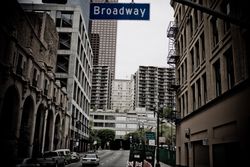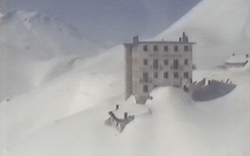Les logements construits sur les toits des grandes tours par les résidents eux-mêmes font partie de l’histoire de Hong Kong depuis plus de cinquante ans. Ces structures vont de l’abri rudimentaire où se logent les plus démunis aux constructions à plusieurs étages dotées des commodités de la vie moderne. L’architecte Rufina Wu et le photographe Stefan Canham utilisent les(...)
Théâtre Paul Desmarais
3 mai 2012 , 19h
L'enseignement de... Hong Kong
Actions:
Description:
Les logements construits sur les toits des grandes tours par les résidents eux-mêmes font partie de l’histoire de Hong Kong depuis plus de cinquante ans. Ces structures vont de l’abri rudimentaire où se logent les plus démunis aux constructions à plusieurs étages dotées des commodités de la vie moderne. L’architecte Rufina Wu et le photographe Stefan Canham utilisent les(...)
Théâtre Paul Desmarais
Piero en tête présente des sculptures contemporaines de l’artiste canado-britannique Geoffrey Smedley, ainsi que 30 livres rares datant du XVe au XVIIIe siècle. Les sculptures de Smedley s’inspirent d’une série de dessins de tête humaine, réalisés par le maître de la Renaissance Piero della Francesca. L’exposition relie ces dessins et les sculptures de Smedley à la(...)
Salle octogonale
2 mai 2001 au 16 septembre 2001
Piero en tête
Actions:
Description:
Piero en tête présente des sculptures contemporaines de l’artiste canado-britannique Geoffrey Smedley, ainsi que 30 livres rares datant du XVe au XVIIIe siècle. Les sculptures de Smedley s’inspirent d’une série de dessins de tête humaine, réalisés par le maître de la Renaissance Piero della Francesca. L’exposition relie ces dessins et les sculptures de Smedley à la(...)
Salle octogonale
L’or et la pierre: un regard critique sur l’architecture des banques traite de l’histoire et de l’incidence culturelle de l’architecture des banques, considérées comme typologies en soi et non dans le cadre de l’œuvre d’un architecte ou d’une agence d’architectes. Contraires aux idées reçues voulant qu’elles aient un vocabulaire architectural répétitif et incarnent un(...)
Salles principales
14 novembre 1990 au 24 février 1991
L'or et la pierre : un regard critique sur l'architecture des banques
Actions:
Description:
L’or et la pierre: un regard critique sur l’architecture des banques traite de l’histoire et de l’incidence culturelle de l’architecture des banques, considérées comme typologies en soi et non dans le cadre de l’œuvre d’un architecte ou d’une agence d’architectes. Contraires aux idées reçues voulant qu’elles aient un vocabulaire architectural répétitif et incarnent un(...)
Salles principales
Cara Rachele, chercheure en résidence 2016, présente ses recherches: Cette conférence se penche sur l’explosion de dessins détaillés produits pendant la Renaissance. Elle établit le lien entre l’émergence, au XVIe siècle, du détail devenu un canon du dessin et l’évocation de l’antique matériel. L’évolution organique de la façon de dessiner les détails transparaît dans(...)
11 août 2016, 18h
Séminaire de chercheur en résidence : Cara Rachele
Actions:
Description:
Cara Rachele, chercheure en résidence 2016, présente ses recherches: Cette conférence se penche sur l’explosion de dessins détaillés produits pendant la Renaissance. Elle établit le lien entre l’émergence, au XVIe siècle, du détail devenu un canon du dessin et l’évocation de l’antique matériel. L’évolution organique de la façon de dessiner les détails transparaît dans(...)
La chercheure en résidence Katie Lloyd Thomas présente sa recherche: Au Royaume-Uni, lappellation et la sélection des produits de construction — ou «achats» au nom du client — ne sont devenues une partie intégrale du rôle de larchitecte que lors de la vaste expansion de la production de masse dans les années 1930. Ces transformations radicales, largement ignorées(...)
Maison Shaughnessy
20 juillet 2017, 18h
Séminaire de chercheur en résidence : Katie Lloyd Thomas
Actions:
Description:
La chercheure en résidence Katie Lloyd Thomas présente sa recherche: Au Royaume-Uni, lappellation et la sélection des produits de construction — ou «achats» au nom du client — ne sont devenues une partie intégrale du rôle de larchitecte que lors de la vaste expansion de la production de masse dans les années 1930. Ces transformations radicales, largement ignorées(...)
Maison Shaughnessy
Barbara Penner, historienne de l’architecture, retrace l’évolution des Chutes du Niagara, de leur statut de destination phare pour jeunes mariés au XIXe siècle à celui d’icône postindustrielle kitsch, avant de redevenir la destination par excellence des jeunes mariés. Le photographe Alec Soth, dont les travaux constituent l’amorce de cette causerie présentée par Barbara(...)
Théâtre Paul-Desmarais
23 avril 2009
L'enseignement de... Niagara Falls
Actions:
Description:
Barbara Penner, historienne de l’architecture, retrace l’évolution des Chutes du Niagara, de leur statut de destination phare pour jeunes mariés au XIXe siècle à celui d’icône postindustrielle kitsch, avant de redevenir la destination par excellence des jeunes mariés. Le photographe Alec Soth, dont les travaux constituent l’amorce de cette causerie présentée par Barbara(...)
Théâtre Paul-Desmarais
Le chercheur en résidence Irene Sunwoo présente sa recherche : Dans les années 1970 et 1980, l’Architectural Association (AA) à Londres a mis à l’essai un modèle d’éducation architecturale « du marché », appuyant un éventail d’études théoriques. Explorant des questions concernant entre autres la politique, la phénoménologie, la sémiotique, la durabilité, la littérature(...)
Maison Shaughnessy
27 juillet 2017, 18h
Séminaire de chercheur en résidence : Irene Sunwoo
Actions:
Description:
Le chercheur en résidence Irene Sunwoo présente sa recherche : Dans les années 1970 et 1980, l’Architectural Association (AA) à Londres a mis à l’essai un modèle d’éducation architecturale « du marché », appuyant un éventail d’études théoriques. Explorant des questions concernant entre autres la politique, la phénoménologie, la sémiotique, la durabilité, la littérature(...)
Maison Shaughnessy
L’exposition, qui marque le 10e anniversaire de l’inauguration du CCA au public, met en valeur et en interaction les acquisitions dans ses dix premières années. En chantier propose plus de 350 estampes, dessins, photographies, livres rares, manuscrits, jouets et maquettes qui démontrent comment l’architecture a été imaginée, conçue, observée et perçue pendant cinq siècles(...)
Salles principales et vitrines
24 novembre 1999 au 30 avril 2000
En chantier : les collections du CCA, 1989-1999
Actions:
Description:
L’exposition, qui marque le 10e anniversaire de l’inauguration du CCA au public, met en valeur et en interaction les acquisitions dans ses dix premières années. En chantier propose plus de 350 estampes, dessins, photographies, livres rares, manuscrits, jouets et maquettes qui démontrent comment l’architecture a été imaginée, conçue, observée et perçue pendant cinq siècles(...)
Salles principales et vitrines
Richard Schave, un historien et guide de Los Angeles, analyse le développement de la ville depuis le tournage du documentaire urbain Reyner Banham Loves Los Angeles (R.-U.,1972), il y a 35 ans. Schave, un ancien étudiant de Banham, présente les recherches de son professeur en confrontant ses propres photographies documentaires à des extraits du film. Il analyse plus(...)
Théâtre Paul-Desmarais
28 mai 2009
L'enseignement de... Los Angeles
Actions:
Description:
Richard Schave, un historien et guide de Los Angeles, analyse le développement de la ville depuis le tournage du documentaire urbain Reyner Banham Loves Los Angeles (R.-U.,1972), il y a 35 ans. Schave, un ancien étudiant de Banham, présente les recherches de son professeur en confrontant ses propres photographies documentaires à des extraits du film. Il analyse plus(...)
Théâtre Paul-Desmarais
articles
